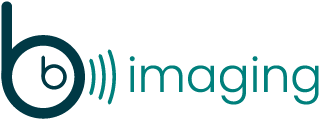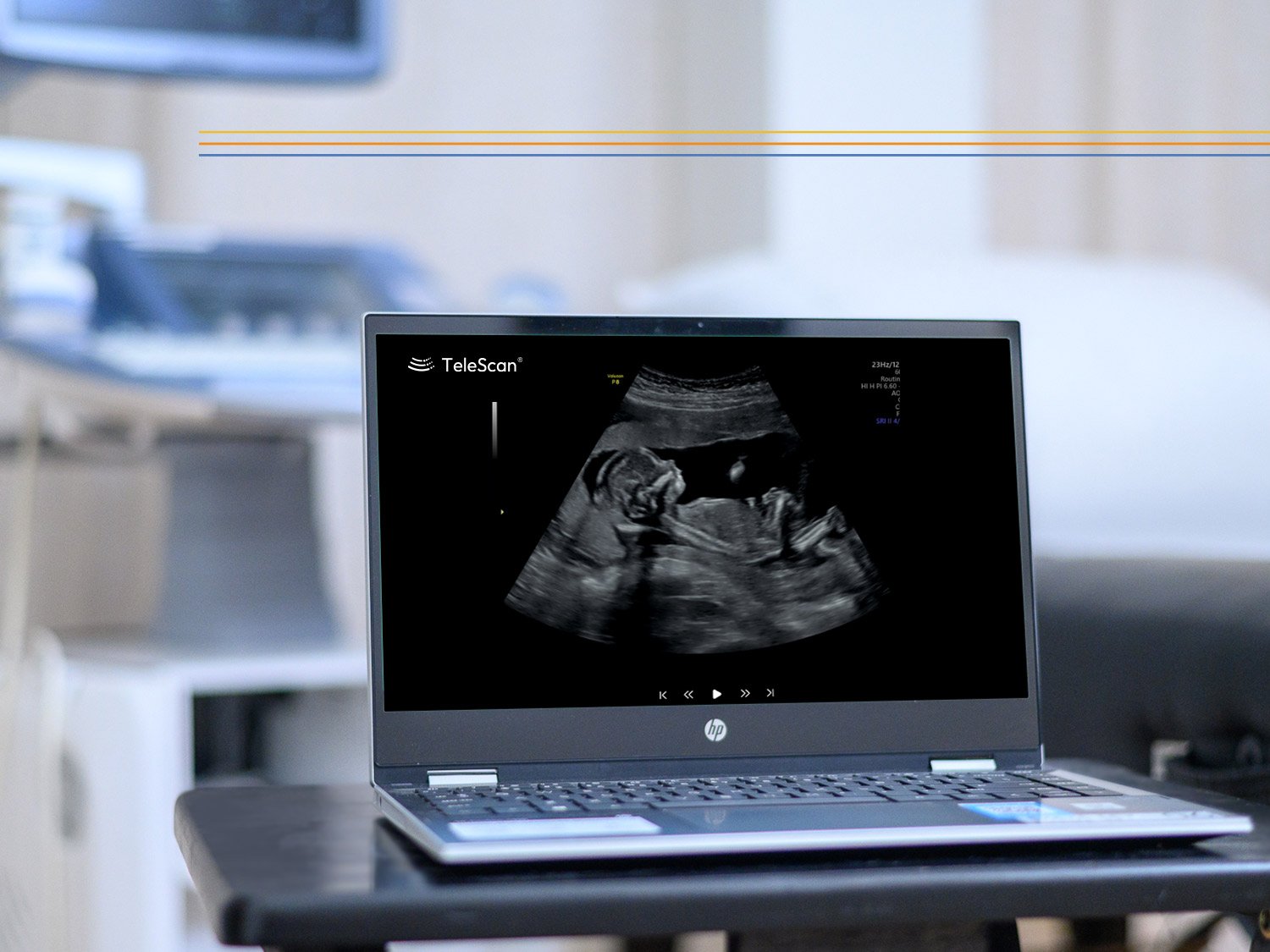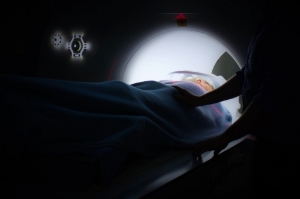What does a telesonographer® really think about TeleScan? We’re glad you asked! This month we spoke with several of the sonographers who work with TeleScan and asked them to rate its effectiveness in several areas. We also asked about how their telesonography® work experience compares to in-clinic scanning. Think of it like a product review, brought to you by true sonography experts—and we mean experts. Each one meets the following credentials:
-
Graduated a CAAHEP-accredited diagnostic medical sonography program
-
Holds active registries in OB/GYN and Fetal Echocardiography through the ARDMS
-
Holds active Nuchal Translucency, Nasal Bone, and Cervical Length Education and Review credentials
-
Has a minimum of two years of maternal fetal medicine sonography experience
Now that you know about our reviewing experts, let’s briefly introduce TeleScan.
Overview of the technology
TeleScan is a telesonography-as-a-service software that connects providers and their patients with expert perinatal sonographers. It boasts FDA clearance, HIPAA-compliance, and supports AIUM accreditation criteria.
Here’s how it works: Underutilized healthcare workers (typically medical assistants) learn to capture cine clips and upload them to the platform. There, the cine clips are reviewed by a certified perinatal telesonographer who provides annotations and measurements and compiles a preliminary diagnostic report. When the report is ready, the provider accesses the report through the TeleScan software, and can modify the report, remeasure structures, add their conclusions, and sign before relaying results to the patient. Patients can also opt to have selected keepsake images sent to their phone.
It’s important to note TeleScan wasn’t built to replace bedside sonographer care, but to fill a gap where such care is unavailable. It augments access to prenatal ultrasound and acts as a gateway to specialist care for those patients who don’t otherwise have access.
Now it’s time to find out: do sonographers think this care model works?
Image quality is high, has same dependencies as in-clinic machines
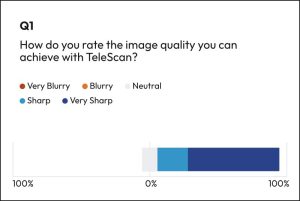
The majority of telesonographers surveyed found TeleScan’s image quality to be very sharp, with one skeptical sonographer saying she was pleasantly surprised at the level of quality. Respondents pointed out several external dependencies that influence image quality, whether using TeleScan or traditional methods—things like body mass index, maternal habitus, fetal position, the quality of the machine being used. They also agreed that slowly captured images were of better quality than those that were captured quickly. One sonographer felt that with properly paced image capture, “Telescan’s image quality isn’t any different than if a sonographer was scanning.” Another responded, “With TeleScan’s imaging, I am able to see everything I would normally see in-clinic.”
High diagnostic accuracy leads to identification of even small abnormalities
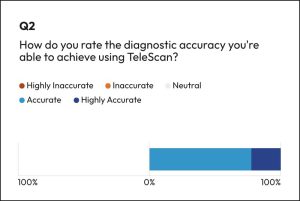
Allowing for the same external dependencies mentioned previously, telesonographers feel TeleScan images enable high diagnostic accuracy. Pointing to helpful software features like image contrast adjustments and zoom, they are confident in their measurements, annotations, and reporting abilities. “The diagnostic accuracy is pretty great,” said one respondent. “I have noticed that I, along with other telesonographers, have been able to pick up abnormal findings, even if they are small findings.” A second respondent agreed, “It’s been very helpful in being able to see any anomalies that might be present.”
Software lends itself to efficiency, provides room for upgrades
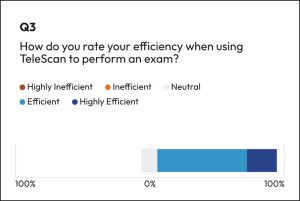
Respondents believe TeleScan exams run efficiently, pointing to the software’s user-friendliness, the ability to prep areas of the report before images begin transferring, the use of templates to help complete certain sections, and the quickness of communication with the healthcare worker capturing the cine clips. Some respondents pointed to the experience level of the healthcare worker capturing the cine clips as a factor, but agreed that as experience increased, so did efficiency.
“Once I was trained and got the hang of it, Telescan had me performing exams, writing reports, and sending them to the physician in what felt like half the time it would have taken in-clinic,” said one respondent. “To me, that’s amazing! Especially when you are providing high-quality care to patients who previously would not have been able to receive that kind of care.”
Several respondents had specific recommendations regarding scrolling, button functions, and tab management—all of which are being addressed in an upcoming redesign. One sonographer was especially pleased that, “there’s always work being done on the quirks.”
For more on TeleScan’s demonstrated efficiency, check out our peer-reviewed white paper.
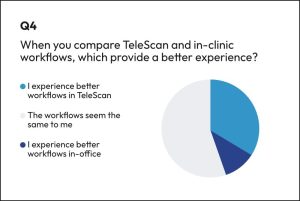
The majority of respondents indicated telesonography and in-clinic workflows feel just about the same, with several suggesting there can be complications in both models. TeleScan image transfer can experience hiccups at times (especially early-on as we work out any bugs with our partners’ IT teams). On the other hand, in-clinic frustrations included getting pulled in other directions while trying to focus on the patient, needing to lookup patient info, having trouble finding an open ultrasound room, and waiting on the doctor to speak with the patient.
Some respondents mentioned that TeleScan’s workflows improve the patient experience. Patients can be in and out of their ultrasound much quicker, which in turn keeps the schedule moving for other appointments.
One respondent summed it up well, “Each type of workflow has its own pros and cons. I don’t necessarily think one is better than the other, but know they both have a place in this field.”
User-friendliness makes the telesonography transition easy
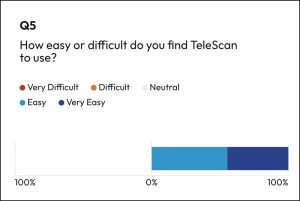
Despite the changes the telesonographers want to see in TeleScan screens, all agree that TeleScan in its current state scores high in user-friendliness. Respondents said clear instructions, understandable labeling, and completeness indicators lead to a general ease of use. Two respondents mentioned that TeleScan also continues to get more user-friendly with each subsequent update. One said, “The design team has taken our feedback and really prioritized the features that we need and use the most.”
Another respondent pointed to the ease of transitioning from onsite scanning to telesonography: “All you need are MFM skills and basic computer skills.”
Work-from-home environment reduces stress levels
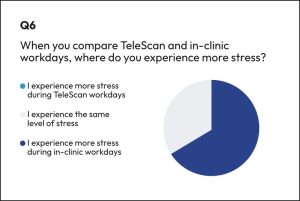
While respondents acknowledged the stress that can come from tech issues with TeleScan, not a single one believes telesonography workdays are more stressful than their in-office counterpart. The majority, in fact, feel onsite workdays are more stressful, mostly due to a busier environment and an inability to focus on one thing at a time. Conversely, work-from-home benefits including the lack of a commute, more control over their environment, increased focus, and rest for their sore arms make TeleScan workdays less stressful for most.
A flexible schedule increases work-life balance
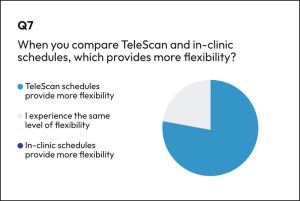
Work-from-home benefits also headlined our conversations about schedule flexibility. The lack of a commute plus the comfort of home results in a better work-life balance for most respondents. They also highlighted the ability to perform their jobs from anywhere with a secure internet connection. One respondent was especially glad to be home when her kids left and came back from school, and the flexibility to stay home with them when they’re sick without missing a day of work. Another pointed to the ability to take a short breather between patients: “I am able to relax my brain in between patients, which is so important. You want to be able to give each patient you see that day 100%, and that can be very hard when you are scanning one right after the other.”
The bottom line
As a new and innovative care model, TeleScan scores well among seasoned sonographers who have made the transition to telesonography. Its image quality, diagnostic accuracy, and workflows closely mirror what is available from a traditional ultrasound machine. Efficiency levels are also similar from a sonographer standpoint, but TeleScan provides an upgrade in efficiency on the patient side. TeleScan’s workday experience is also highly rated thanks to the software’s user-friendliness and the ability to work from home, which contributes to lower stress and more flexible schedules.
Please use the comments section below to let us know what other questions you have. If this sounds like something you want to be a part of, check out our telesonographer application. To see more of the software and learn how to bring TeleScan to your clinic, click the button below:
Please note: the opinions in this article reflect the software’s capability as of January 2024.
